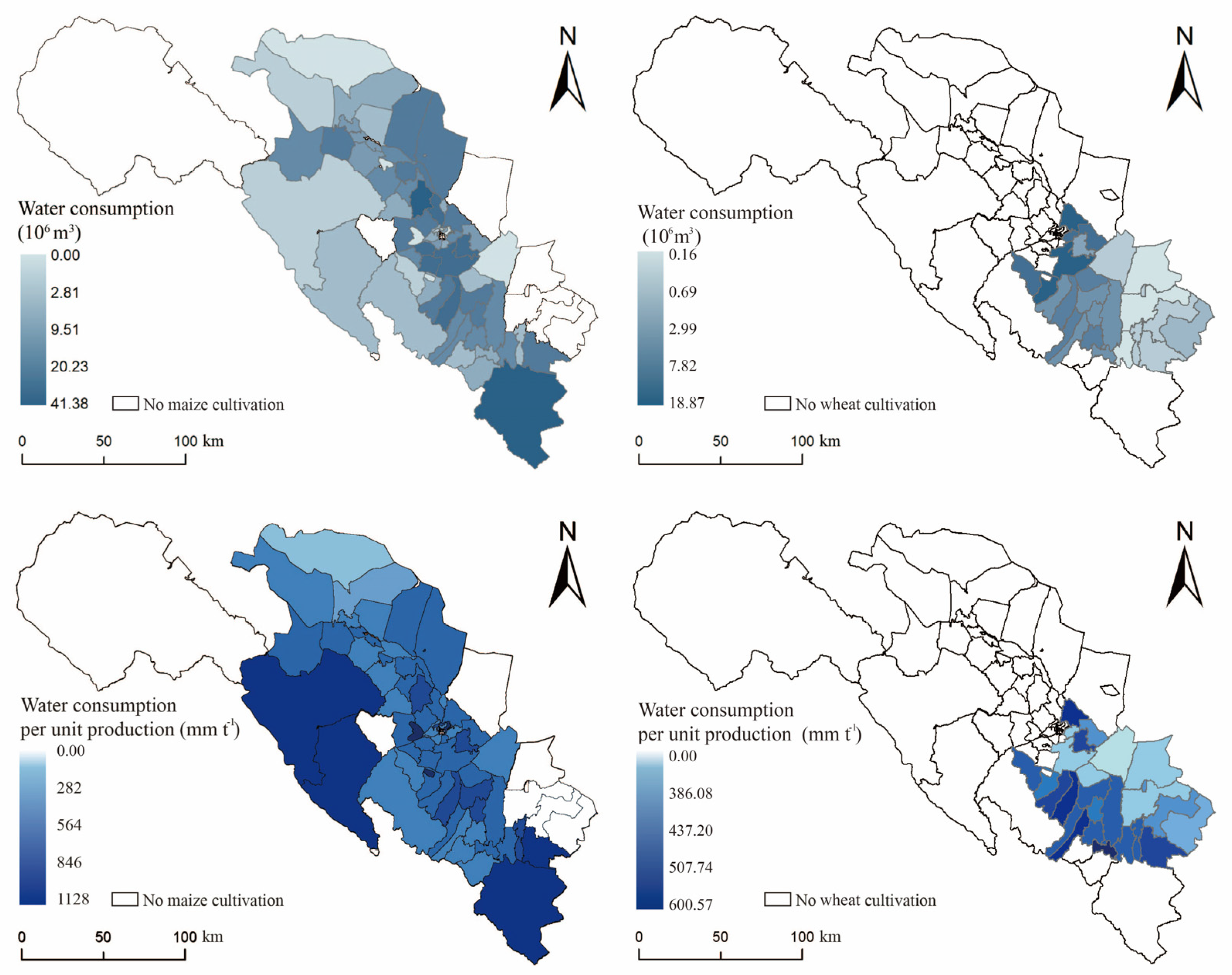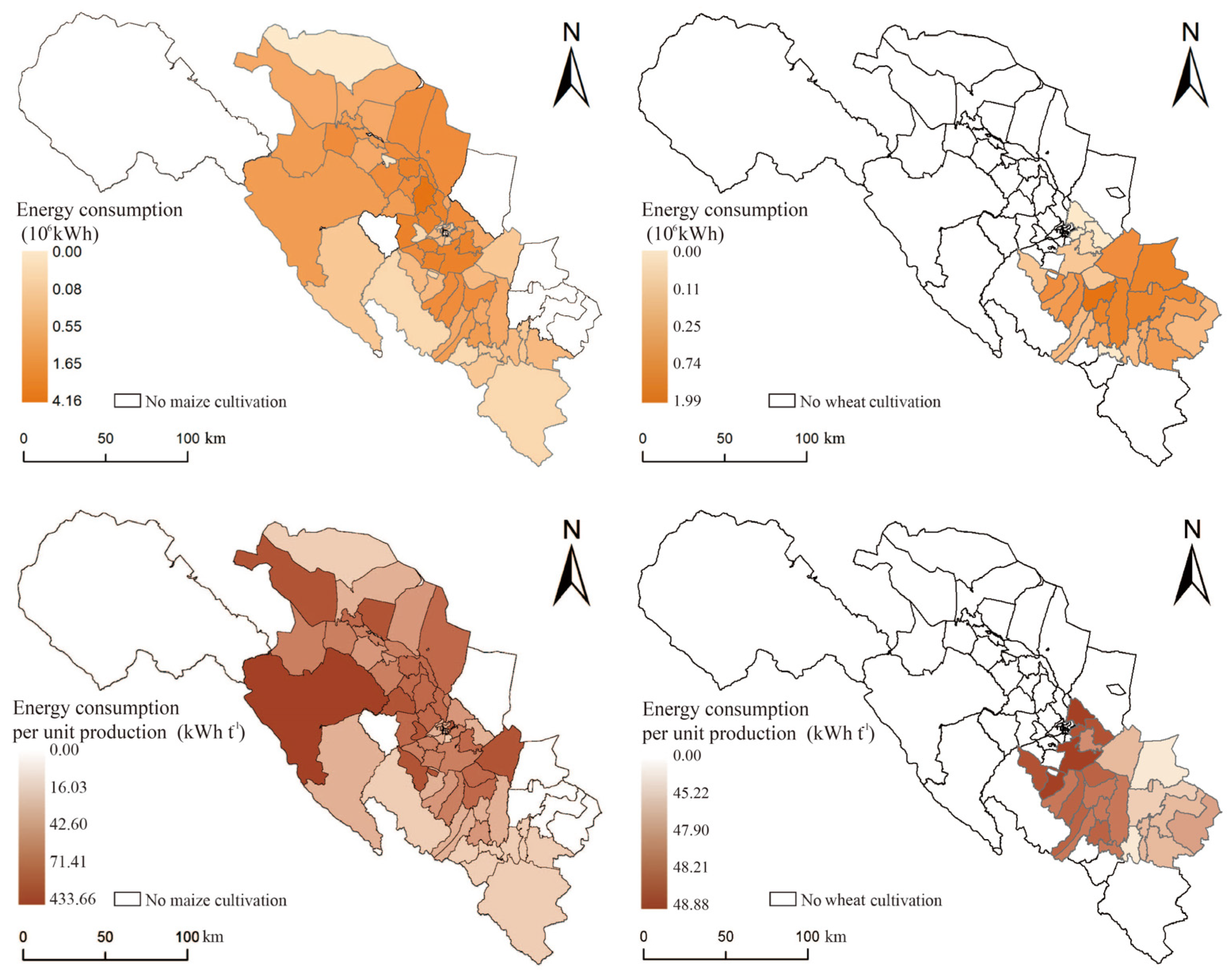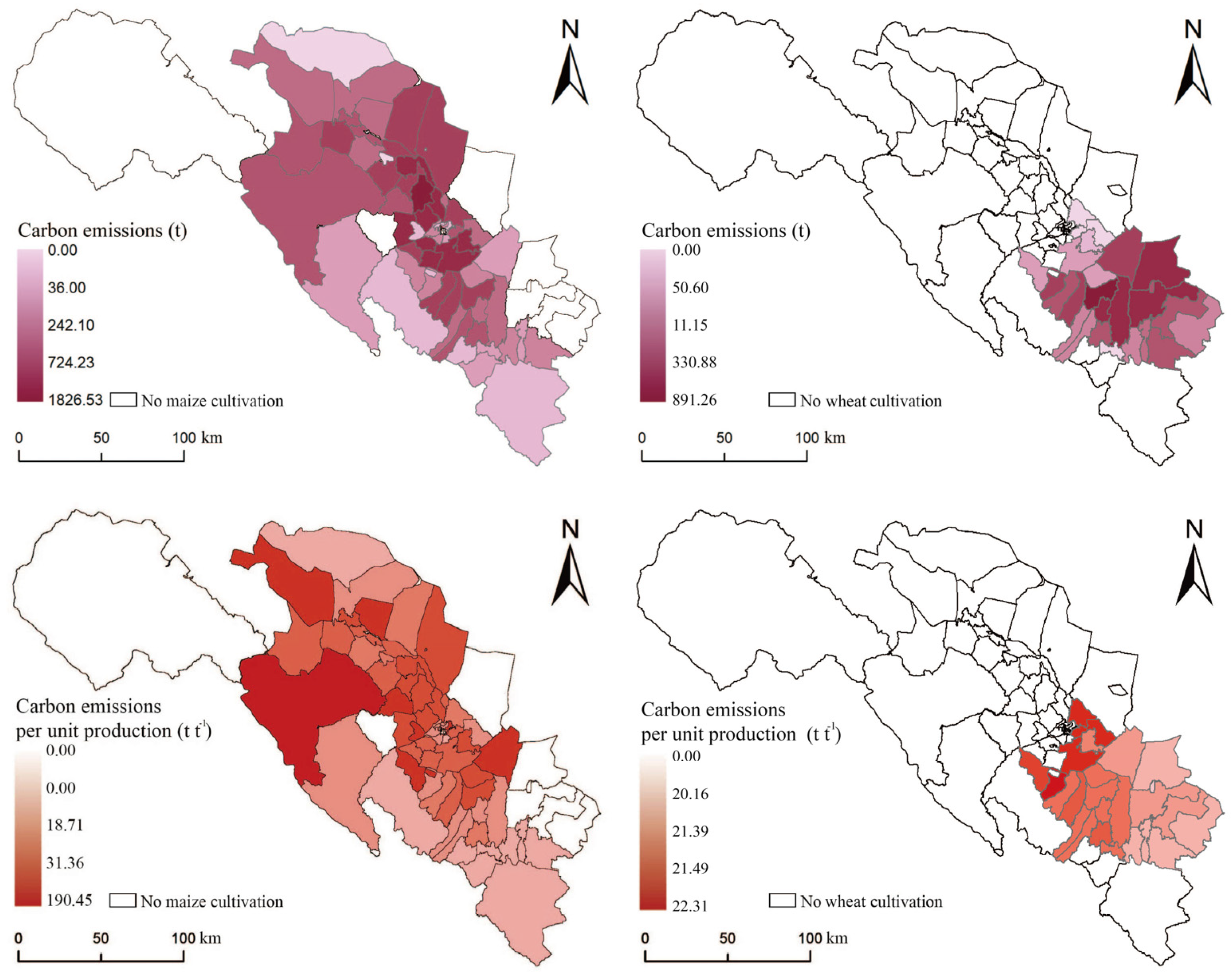Agricultural Cultivation Structure in Arid Areas Based on Water–Carbon Nexus—Taking the Middle Reaches of the Heihe River as an Example
Abstract
1. Introduction
2. Materials and Methods
2.1. Study Area
2.2. Methods and Data
2.2.1. Data Source
2.2.2. Data Integration at Different Scales
2.2.3. Constructing Carbon Emission Linkage of Irrigated Waters for Agricultural Irrigation Process
2.2.4. Sown Area and Yield
2.2.5. Measurement of Water Consumption in Agricultural Irrigation
2.2.6. Carbon Emissions
2.2.7. Planting Structure Optimization Model
3. Results
3.1. Differences in Spatial Patterns of Irrigation Water Consumption
3.2. Differences in Spatial Patterns of Water-Related Carbon Emissions
3.3. Differences in Spatial Patterns of Carbon Emissions from Irrigation
3.4. Agricultural Planting Structure Adjustment under Linear Programming Model
4. Discussion
4.1. A Trade-off among Low-Carbon Agriculture, Irrigation Water Security, and Food Security
4.2. Spatial Differences in Irrigation Water Consumption of Major Food Crops in Arid Regions
5. Conclusions
Author Contributions
Funding
Data Availability Statement
Conflicts of Interest
References
- Suh, S.; Johnson, J.A.; Tambjerg, L.; Sim, S.; Broeckx-Smith, S.; Reyes, W.; Chaplin-Kramer, R. Closing yield gap is crucial to avoid potential surge in global carbon emissions. Glob. Environ. Chang. 2020, 63, 102100. [Google Scholar] [CrossRef]
- Xia, C.; Li, Y.; Xu, T.; Chen, Q.; Ye, Y.; Shi, Z.; Liu, J.; Ding, Q.; Li, X. Analyzing spatial patterns of urban carbon metabolism and its response to change of urban size: A case of the Yangtze River Delta, China. Ecol. Indic. 2019, 104, 615–625. [Google Scholar] [CrossRef]
- Wang, J.; Li, Y.; Huang, J.; Yan, T.; Sun, T. Growing water scarcity, food security and government responses in China. Glob. Food Secur. 2017, 14, 9–17. [Google Scholar] [CrossRef]
- Wallace, J.S.; Gregory, P.J. Water resources and their use in food production systems. Aquat. Sci. 2002, 64, 363–375. [Google Scholar] [CrossRef]
- Kang, S.; Hao, X.; Du, T.; Tong, L.; Su, X.; Lu, H.; Li, X.; Huo, Z.; Li, S.; Ding, R. Improving agricultural water productivity to ensure food security in China under changing environment: From research to practice. Agric. Water Manag. 2017, 179, 5–17. [Google Scholar] [CrossRef]
- Hanjra, M.A.; Qureshi, M.E. Global water crisis and future food security in an era of climate change. Food Policy 2010, 35, 365–377. [Google Scholar] [CrossRef]
- Ahumada, H.; Maizeejo, M. Forecasting food prices: The case of maize, soybeans and wheat. Int. J. Forecast. 2016, 32, 838–848. [Google Scholar] [CrossRef]
- Dong, Z.; Xia, C.; Fang, K.; Zhang, W. Effect of the carbon emissions trading policy on the co-benefits of carbon emissions reduction and air pollution control. Energy Policy 2022, 165, 112998. [Google Scholar] [CrossRef]
- Chen, Z.; Xu, C.; Ji, L.; Feng, J.; Li, F.; Zhou, X.; Fang, F. Effects of multi-cropping system on temporal and spatial distribution of carbon and nitrogen footprint of major crops in China. Glob. Ecol. Conserv. 2020, 22, e00895. [Google Scholar] [CrossRef]
- Hou, X.; Liu, J.; Zhang, D.; Zhao, M.; Xia, C. Impact of urbanization on the eco-efficiency of cultivated land utilization: A case study on the Yangtze River Economic Belt, China. J. Clean. Prod. 2019, 238, 117916. [Google Scholar] [CrossRef]
- Li, M.; Xu, W.; Zhu, T. Agricultural water allocation under uncertainty: Redistribution of water shortage risk. Am. J. Agric. Econ. 2019, 101, 134–153. [Google Scholar] [CrossRef]
- Naderi, M.M.; Mirchi, A.; Bavani, A.R.M.; Goharian, E.; Madani, K. System dynamics simulation of regional water supply and demand using a food-energy-water nexus approach: Application to Qazvin Plain, Iran. J. Environ. Manag. 2021, 280, 111843. [Google Scholar] [CrossRef]
- Dong, Z.; Chen, W.; Wang, S. Emission reduction target, complexity and industrial performance. J. Environ. Manag. 2020, 260, 110148. [Google Scholar] [CrossRef]
- Tang, Y.H.; Luan, X.B.; Sun, J.X.; Zhao, J.F.; Yin, Y.L.; Wang, Y.B.; Sun, S.K. Impact assessment of climate change and human activities on GHG emissions and agricultural water use. Agric. For. Meteorol. 2021, 296, 108218. [Google Scholar] [CrossRef]
- Liu, Y.; Xia, C.; Ou, X.; Lv, Y.; Ai, X.; Pan, R.; Zhang, Y.; Shi, M.; Zheng, X. Quantitative structure and spatial pattern optimization of urban green space from the perspective of carbon balance: A case study in Beijing, China. Ecol. Indic. 2023, 148, 110034. [Google Scholar] [CrossRef]
- Pellegrini, G.; Ingrao, C.; Camposeo, S.; Tricase, C.; Contò, F.; Huisingh, D. Application of water footprint to olive growing systems in the Apulia region: A comparative assessment. J. Clean. Prod. 2016, 112, 2407–2418. [Google Scholar] [CrossRef]
- Lu, Y.; Zhang, X.; Chen, S.; Shao, L.; Sun, H. Changes in water use efficiency and water footprint in grain production over the past 35 years: A case study in the North China Plain. J. Clean. Prod. 2016, 116, 71–79. [Google Scholar] [CrossRef]
- Xia, C.; Chen, B. Urban land-carbon nexus based on ecological network analysis. Appl. Energy 2020, 276, 115465. [Google Scholar] [CrossRef]
- Feng, B.; Zhuo, L.; Xie, D.; Mao, Y.; Gao, J.; Xie, P.; Wu, P. A quantitative review of water footprint accounting and simulation for crop production based on publications during 2002–2018. Ecol. Indic. 2021, 120, 106962. [Google Scholar] [CrossRef]
- Mekonnen, M.M.; Hoekstra, A.Y. The green, blue and grey water footprint of crops and derived crop products. Hydrol. Earth Syst. Sci. 2011, 15, 1577–1600. [Google Scholar] [CrossRef]
- He, L.; Du, Y.; Wu, S.; Zhang, Z. Evaluation of the agricultural water resource carrying capacity and optimization of a planting-raising structure. Agric. Water Manag. 2021, 243, 106456. [Google Scholar] [CrossRef]
- Sun, C.; Yan, X.; Zhao, L. Coupling efficiency measurement and spatial correlation characteristic of water–energy–food nexus in China. Resour. Conserv. Recycl. 2021, 164, 105151. [Google Scholar] [CrossRef]
- Xia, C.; Xiang, M.; Fang, K.; Li, Y.; Ye, Y.; Shi, Z.; Liu, J. Spatial-temporal distribution of carbon emissions by daily travel and its response to urban form: A case study of Hangzhou, China. J. Clean. Prod. 2020, 257, 120797. [Google Scholar] [CrossRef]
- Yu, L.; Liu, S.; Wang, F.; Liu, Y.; Li, M.; Wang, Q.; Dong, S.; Zhao, W.; Tran, L.-S.P.; Sun, Y. Effects of agricultural activities on energy-carbon-water nexus of the Qinghai-Tibet Plateau. J. Clean. Prod. 2022, 331, 129995. [Google Scholar] [CrossRef]
- Li, C.; Jiang, T.T.; Luan, X.B.; Yin, Y.L.; Wu, P.T.; Wang, Y.B.; Sun, S.K. Determinants of agricultural water demand in China. J. Clean. Prod. 2021, 288, 125508. [Google Scholar] [CrossRef]
- Davis, K.F.; Rulli, M.C.; Seveso, A.; D’Odorico, P. Increased food production and reduced water use through optimized crop distribution. Nat. Geosci. 2017, 10, 919–924. [Google Scholar] [CrossRef]
- Zhao, W.; Liu, B.; Zhang, Z. Water requirements of maize in the middle Heihe River basin, China. Agric. Water Manag. 2010, 97, 215–223. [Google Scholar] [CrossRef]
- Chen, Y.; Zhang, D.; Sun, Y.; Liu, X.; Wang, N.; Savenije, H.H.G. Water demand management: A case study of the Heihe River Basin in China. Phys. Chem. Earth Parts A B C 2005, 30, 408–419. [Google Scholar] [CrossRef]
- Lu, L.; Li, X.; Cheng, G. Landscape evolution in the middle Heihe River Basin of north-west China during the last decade. J. Arid. Environ. 2003, 53, 395–408. [Google Scholar] [CrossRef]
- Zhao, J.; Shao, Z.; Xia, C.; Fang, K.; Chen, R.; Zhou, J. Ecosystem services assessment based on land use simulation: A case study in the Heihe River Basin, China. Ecol. Indic. 2022, 143, 109402. [Google Scholar] [CrossRef]
- Fagodiya, R.K.; Singh, A.; Singh, R.; Rani, S.; Kumar, S.; Rai, A.K.; Sheoran, P.; Chandra, P.; Yadav, R.K.; Sharma, P.C.; et al. The food-energy-water-carbon nexus of the rice-wheat production system in the western Indo-Gangetic Plain of India: An impact of irrigation system, conservational tillage and residue management. Sci. Total Environ. 2023, 860, 160428. [Google Scholar] [CrossRef]
- Fan, X.; Zhang, W.; Chen, W.; Chen, B. Land–water–energy nexus in agricultural management for greenhouse gas mitigation. Appl. Energy 2020, 265, 114796. [Google Scholar] [CrossRef]
- Zhu, R.; Zhao, R.; Li, X.; Hu, X.; Jiao, S.; Xiao, L.; Xie, Z.; Sun, J.; Wang, S.; Yang, Q.; et al. The impact of irrigation modes on agricultural water-energy-carbon nexus. Sci. Total Environ. 2023, 860, 160493. [Google Scholar] [CrossRef]
- Nyolei, D.; Diels, J.; Mbilinyi, B.; Mbungu, W.; van Griensven, A. Evapotranspiration simulation from a sparsely vegetated agricultural field in a semi-arid agro-ecosystem using Penman-Monteith models. Agric. For. Meteorol. 2021, 303, 108370. [Google Scholar] [CrossRef]
- Gavilan, P.; Berengena, J.; Allen, R.G. Measuring versus estimating net radiation and soil heat flux: Impact on Penman–Monteith reference ET estimates in semiarid regions. Agric. Water Manag. 2007, 89, 275–286. [Google Scholar] [CrossRef]
- Zarei, A.R.; Moghimi, M.M. Modified version for SPEI to evaluate and modeling the agricultural drought severity. Int. J. Biometeorol. 2019, 63, 911–925. [Google Scholar] [CrossRef]
- Acs, S.; Berentsen, P.B.M.; Huirne, R.B.M. Conversion to organic arable farming in The Netherlands: A dynamic linear programming analysis. Agric. Syst. 2007, 94, 405–415. [Google Scholar] [CrossRef]
- Bauer, S.; Kasnakoglu, H. Non-linear programming models for sector and policy analysis: Experiences with the Turkish agricultural sector model. Econ. Model. 1990, 7, 275–290. [Google Scholar] [CrossRef]
- Bartolini, F.; Bazzani, G.M.; Gallerani, V.; Raggi, M.; Viaggi, D. The impact of water and agriculture policy scenarios on irrigated farming systems in Italy: An analysis based on farm level multi-attribute linear programming models. Agric. Syst. 2007, 93, 90–114. [Google Scholar] [CrossRef]
- Xia, C.; Zhang, J.; Zhao, J.; Xue, F.; Li, Q.; Fang, K.; Shao, Z.; Zhang, J.; Li, S.; Zhou, J. Exploring potential of urban land-use management on carbon emissions—A case of Hangzhou, China. Ecol. Indic. 2023, 146, 109902. [Google Scholar] [CrossRef]
- Karandish, F.; Šimůnek, J. A comparison of the HYDRUS (2D/3D) and SALTMED models to investigate the influence of various water-saving irrigation strategies on the maize water footprint. Agric. Water Manag. 2019, 213, 809–820. [Google Scholar] [CrossRef]
- Yang, G.; Tian, L.; Li, X.; He, X.; Gao, Y.; Li, F.; Xue, L.; Li, P. Numerical assessment of the effect of water-saving irrigation on the water cycle at the Manas River Basin oasis, China. Sci. Total Environ. 2020, 707, 135587. [Google Scholar] [CrossRef] [PubMed]
- Xiao, X.; Fan, L.; Li, X.; Tan, M.; Jiang, T.; Zheng, L.; Jiang, F. Water-use efficiency of crops in the arid area of the middle reaches of the Heihe River: Taking Zhangye City as an example. Water 2019, 11, 1541. [Google Scholar] [CrossRef]
- Li, W.; Ruiz-Menjivar, J.; Zhang, L.; Zhang, J. Climate change perceptions and the adoption of low-carbon agricultural technologies: Evidence from rice production systems in the Yangtze River Basin. Sci. Total Environ. 2021, 759, 143554. [Google Scholar] [CrossRef]
- Zahraee, S.M.; Golroudbary, S.R.; Shiwakoti, N.; Stasinopoulos, P.; Kraslawski, A. Water-energy nexus and greenhouse gas–sulfur oxides embodied emissions of biomass supply and production system: A large scale analysis using combined life cycle and dynamic simulation approach. Energy Convers. Manag. 2020, 220, 113113. [Google Scholar] [CrossRef]
- Xu, Y.; Dong, Z.; Wu, Y. The spatiotemporal effects of environmental regulation on green innovation: Evidence from Chinese cities. Sci. Total Environ. 2023, 876, 162790. [Google Scholar] [CrossRef]
- You, L.; Spoor, M.; Ulimwengu, J.; Zhang, S. Land use change and environmental stress of wheat, rice and maize production in China. China Econ. Rev. 2011, 22, 461–473. [Google Scholar] [CrossRef]
- Fang, K.; Heijungs, R.; de Snoo, G.R. Theoretical exploration for the combination of the ecological, energy, carbon, and water footprints: Overview of a footprint family. Ecol. Indic. 2014, 36, 508–518. [Google Scholar] [CrossRef]
- Zhuang, R.; Abbott, P. Price elasticities of key agricultural commodities in China. China Econ. Rev. 2007, 18, 155–169. [Google Scholar] [CrossRef]
- Dong, Z.; Wang, S.; Zhang, W.; Shen, H. The dynamic effect of environmental regulation on firms’ energy consumption behavior-Evidence from China’s industrial firms. Renew. Sustain. Energy Rev. 2022, 156, 111966. [Google Scholar] [CrossRef]
- Mahlknecht, J.; González-Bravo, R.; Loge, F.J. Water-energy-food security: A Nexus perspective of the current situation in Latin America and the Caribbean. Energy 2020, 194, 116824. [Google Scholar] [CrossRef]
- Niu, K.-Y.; Guo, H.; Liu, J. Can food security and low carbon be achieved simultaneously?—An empirical analysis of the mechanisms influencing the carbon footprint of potato and maize cultivation in irrigation areas. J. Integr. Agric. 2023, 22, 1230–1243. [Google Scholar] [CrossRef]
- Hou, J.; Hou, B. Farmers’ adoption of low-carbon agriculture in China: An extended theory of the planned behavior model. Sustainability 2019, 11, 1399. [Google Scholar] [CrossRef]
- Kahiluoto, H.; Smith, P.; Moran, D.; Olesen, J. Enabling food security by verifying agricultural carbon. Nat. Clim. Chang. 2014, 4, 309–311. [Google Scholar] [CrossRef]
- Liu, Y.; Song, W.; Deng, X. Changes in crop type distribution in Zhangye City of the Heihe River Basin, China. Appl. Geogr. 2016, 76, 22–36. [Google Scholar] [CrossRef]
- Norse, D. Low carbon agriculture: Objectives and policy pathways. Environ. Dev. 2012, 1, 25–39. [Google Scholar] [CrossRef]
- Niu, J.; Liu, Q.; Kang, S.; Zhang, X. The response of crop water productivity to climatic variation in the upper-middle reaches of the Heihe River basin, Northwest China. J. Hydrol. 2018, 563, 909–926. [Google Scholar] [CrossRef]
- Cai, B.; Zhang, L.; Xia, C.; Yang, L.; Liu, H.; Jiang, L.; Cao, L.; Lei, Y.; Yan, G.; Wang, J. A new model for China’s CO2 emission pathway using the top-down and bottom-up approaches. Chin. J. Popul. Resour. Environ. 2021, 19, 291–294. [Google Scholar] [CrossRef]
- Liu, Q.; Niu, J.; Wood, J.D.; Kang, S. Spatial optimization of cropping pattern in the upper-middle reaches of the Heihe River basin, Northwest China. Agric. Water Manag. 2022, 264, 107479. [Google Scholar] [CrossRef]
- Zhang, Y.; Liu, W.; Cai, Y.; Khan, S.U.; Zhao, M. Decoupling analysis of water use and economic development in arid region of China—Based on quantity and quality of water use. Sci. Total Environ. 2021, 761, 143275. [Google Scholar] [CrossRef]
- Xia, C.; Li, Y.; Xu, T.; Ye, Y.; Shi, Z.; Peng, Y.; Liu, J. Quantifying the spatial patterns of urban carbon metabolism: A case study of Hangzhou, China. Ecol. Indic. 2018, 95, 474–484. [Google Scholar] [CrossRef]
- Xia, C.; Dong, Z.; Wu, P.; Dong, F.; Fang, K.; Li, Q.; Li, X.; Shao, Z.; Yu, Z. How urban land-use intensity affected CO2 emissions at the county level: Influence and prediction. Ecol. Indic. 2022, 145, 109601. [Google Scholar] [CrossRef]
- Wang, J.; Gao, X.; Huang, K.; Yuan, Y.; Wang, A.; Dong, L.; Zhao, X. A remote sensing-based method for high-resolution crop water footprint quantification in an irrigation district with complex planting structure. J. Hydrol. 2023, 617, 129030. [Google Scholar] [CrossRef]
- Fang, K.; He, J.; Liu, Q.; Wang, S.; Geng, Y.; Heijungs, R.; Du, Y.; Yue, W.; Xu, A.; Fang, C. Water footprint of nations amplified by scarcity in the Belt and Road Initiative. Heliyon 2023, 9, e12957. [Google Scholar] [CrossRef]
- Sadras, V.; Roget, D.; O’Leary, G. On-farm assessment of environmental and management constraints to wheat yield and efficiency in the use of rainfall in the Mallee. Aust. J. Agric. Res. 2002, 53, 587–598. [Google Scholar] [CrossRef]
- Gong, X.; Zhang, H.; Ren, C.; Sun, D.; Yang, J. Optimization allocation of irrigation water resources based on crop water requirement under considering effective precipitation and uncertainty. Agric. Water Manag. 2020, 239, 106264. [Google Scholar] [CrossRef]
- Meng, C.; Du, X.; Zhu, M.; Ren, Y.; Fang, K. The static and dynamic carbon emission efficiency of transport industry in China. Energy 2023, 274, 127297. [Google Scholar] [CrossRef]
- Wang, G.; Chen, J.; Wu, F.; Li, Z. An integrated analysis of agricultural water-use efficiency: A case study in the Heihe River Basin in Northwest China. Phys. Chem. Earth Parts A B C 2015, 89–90, 3–9. [Google Scholar] [CrossRef]
- Luo, J.; Zhang, H.; Qi, Y.; Pei, H.; Shen, Y. Balancing water and food by optimizing the planting structure in the Beijing–Tianjin–Hebei region, China. Agric. Water Manag. 2022, 262, 107326. [Google Scholar] [CrossRef]






| Point Number | Wheat | Corn | Tubers |
|---|---|---|---|
| Zhangye City (Total) | 0.17 | 0.48 | 0.10 |
| Ganzhou District | 0.04 | 0.92 | 0.00 |
| Sunan County | 0.14 | 0.27 | 0.03 |
| Minle County | 0.38 | 0.13 | 0.31 |
| Linze County | 0.01 | 0.97 | 0.00 |
| Gaotai County | 0.10 | 0.65 | 0.04 |
| Shandan County | 0.42 | 0.03 | 0.23 |
Disclaimer/Publisher’s Note: The statements, opinions and data contained in all publications are solely those of the individual author(s) and contributor(s) and not of MDPI and/or the editor(s). MDPI and/or the editor(s) disclaim responsibility for any injury to people or property resulting from any ideas, methods, instructions or products referred to in the content. |
© 2023 by the authors. Licensee MDPI, Basel, Switzerland. This article is an open access article distributed under the terms and conditions of the Creative Commons Attribution (CC BY) license (https://creativecommons.org/licenses/by/4.0/).
Share and Cite
Li, B.; Niu, M.; Zhao, J.; Zheng, X.; Chen, R.; Ling, X.; Li, J.; Wang, Y. Agricultural Cultivation Structure in Arid Areas Based on Water–Carbon Nexus—Taking the Middle Reaches of the Heihe River as an Example. Land 2023, 12, 1442. https://doi.org/10.3390/land12071442
Li B, Niu M, Zhao J, Zheng X, Chen R, Ling X, Li J, Wang Y. Agricultural Cultivation Structure in Arid Areas Based on Water–Carbon Nexus—Taking the Middle Reaches of the Heihe River as an Example. Land. 2023; 12(7):1442. https://doi.org/10.3390/land12071442
Chicago/Turabian StyleLi, Boxuan, Meng Niu, Jing Zhao, Xi Zheng, Ran Chen, Xiao Ling, Jinxin Li, and Yuxiao Wang. 2023. "Agricultural Cultivation Structure in Arid Areas Based on Water–Carbon Nexus—Taking the Middle Reaches of the Heihe River as an Example" Land 12, no. 7: 1442. https://doi.org/10.3390/land12071442
APA StyleLi, B., Niu, M., Zhao, J., Zheng, X., Chen, R., Ling, X., Li, J., & Wang, Y. (2023). Agricultural Cultivation Structure in Arid Areas Based on Water–Carbon Nexus—Taking the Middle Reaches of the Heihe River as an Example. Land, 12(7), 1442. https://doi.org/10.3390/land12071442




